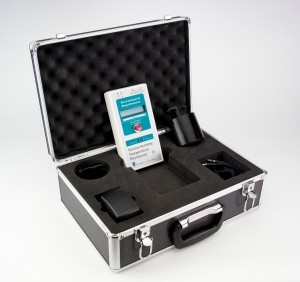Understand the Decade Scale
How to read a Surface Resistance Meter.
The Decade Scale is shorthand for electrical measurements, displayed in powers of 10
and described in “Ohms”. A Surface Resistivity Meter is used to take these electrical measurements on all types of surfaces and materials, and the results are displayed in the Decade Scale.  Most meters will display results using colored LEDs that brighten according to each decade. These measurements are important in ESD control because this is how to classify a material as Conductive, Dissipative or Insulative.
Ohms are the units used to describe the  measurements of electrical resistance and has a symbol that looks like this “Ω”. Depending on the value, measurements can be in “kilohms”, or “meg ohms”. The decade scale can be written in several ways and mean the same: 105 , 10^5, 100 kilohms, or 100megΩ etc. The table below shows all the values important as it pertains to ESD or Static Control:
| Color- typical for most meters) | Indicating Function | ohm |
| Green | Conductive | 10^3-10^5 |
| Yellow | Dissipative: ideal test measurement | 3×10^5-10^9 |
| Orange | Dissipative but nearing insulative level | 3×10^9-10^10 |
| Red | Near insulative to insulative | 10^11-10^12 |
Decade Scale
10^3     =1 kilohm
10^4     =10 kilohm
10^5     =100 kilohm
3×10^5 =300 kilohm
10^6     =1 meg ohm
3×10^6 =3 meg ohm
10^7     =10 meg ohm
3×10^7 =30 meg ohm
10^8     =100 meg ohm
3×10^8 =300 meg ohm
10^9     =3000 meg ohm
3×10^9 =1000 meg ohm
10^10   =10,000 meg ohm
10^11   =100,000 meg ohm
10^12   =1,000,000 meg ohm
To learn more about the Decade Scale and Surface Resistivity Meters visit Transforming Technologies or call 419-841-9552

